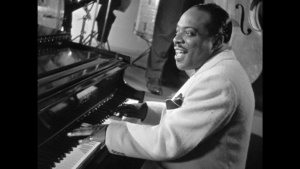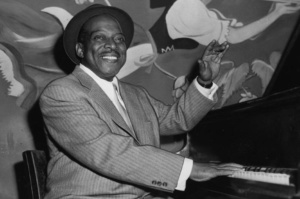Stories of Standards—One O’Clock Jump
 Tune in weekday mornings for Stories of Standards to hear our favorite versions of “One O’Clock Jump.” Rodney Franks presents Stories of Standards Monday through Friday at 7:50 and 8:50 a.m. starting Monday, July 13!
Tune in weekday mornings for Stories of Standards to hear our favorite versions of “One O’Clock Jump.” Rodney Franks presents Stories of Standards Monday through Friday at 7:50 and 8:50 a.m. starting Monday, July 13!
Stories of Standards is sponsored by ListenUp.
“One O’Clock Jump” (1938) began as a 12-bar blues arranged by Count Basie and Buster Smith (alto saxophone), based on a Fats Waller tune “Six or Seven Times”. The band was playing at the Reno, a bar with the advantage of being one of four experimental high-fidelity radio stations in the United States, with an exceptionally large reception area. The music was broadcast live; the radio announcer asked for the title, decided he couldn’t use “Blue Balls” on the air and suggested a new title. It was almost one a.m.; he came up with “One O’Clock Jump”, which has been used ever since. This unfortunately unnamed announcer also was the first to use the name “Count Basie” instead of “Bill Basie”. Basie, describing its origins, said “we hit it with the rhythm section and went into the riffs, and the riffs just stuck. We set the thing up front in D-flat, and then we just went on playing in F.” Basie adopted “One O’Clock Jump” as his theme song and closed the band’s first recorded radio performance with the tune.They recorded “One O’clock Jump” on their first recording session for Decca Records on January 21, 1937, an immediate hit for Basie and the first for the group following their arrival in New York City. Benny Goodman played “One O’Clock Jump” in his 1938 concert at Carnegie Hall and it was the last song ever recorded by Earl “Fatha” Hines in 1981. Lionel Hampton used it as his theme song for a while. The song was inducted into the Grammy Hall of Fame in 1979; it was later listed among the “Songs of the Century”. The Library of Congress in 2005 included “One O’Clock Jump” in the National Recording Registry .
 Count Basie (William Alllen Basie) (Aug 21, 1904 – Apr 26, 1984) was born in New Jersey to a mellophone-playing father and piano-playing mother. When young he preferred drums to piano, but was convinced that he couldn’t equal Sonny Greer on drums, so went to piano exclusively when 15 years old and was a protege of Fats Waller, spending time literally sitting at his feet. Basie toured with several vaudeville troupes, one of which disbanded in Kansas City in 1927, leaving him stranded. He played with Walter Page’s Blue Devils from 1928 through 1929, then joined Bennie Moten’s band. After Moten’s unexpected death in 1935 Basie soloed for a while, then formed the Barons of Rhythm, a 9-piece band which included many former members of the Moten band plus Lester Young. In 1936 John Hammond (record producer, civil rights activist, music critic and talent scout), was in Chicago with only one radio station available, where he heard Count Basie for the first time. Hammond immediately began writing about the band in Down Beat and other journals, advising everyone to tune in to the little band broadcasting from Kansas City. Basie led jazz bands from 1935 until his death in 1984, with few interruptions. Although big bands lost some popularity after the war, Europeans appreciated jazz and Basie took his band on a European tour in 1958. They also toured with the “Birdland Stars of 1955”, whose lineup included Sarah Vaughan, Erroll Garner, Lester Young, George Shearing, and Stan Getz. Leading the band into the 1980s, Basie also made a few movie appearances, including the Jerry Lewis film “Cinderfella” (1960) and Mel Brooks’ film “Blazing Saddles” (1974).
Count Basie (William Alllen Basie) (Aug 21, 1904 – Apr 26, 1984) was born in New Jersey to a mellophone-playing father and piano-playing mother. When young he preferred drums to piano, but was convinced that he couldn’t equal Sonny Greer on drums, so went to piano exclusively when 15 years old and was a protege of Fats Waller, spending time literally sitting at his feet. Basie toured with several vaudeville troupes, one of which disbanded in Kansas City in 1927, leaving him stranded. He played with Walter Page’s Blue Devils from 1928 through 1929, then joined Bennie Moten’s band. After Moten’s unexpected death in 1935 Basie soloed for a while, then formed the Barons of Rhythm, a 9-piece band which included many former members of the Moten band plus Lester Young. In 1936 John Hammond (record producer, civil rights activist, music critic and talent scout), was in Chicago with only one radio station available, where he heard Count Basie for the first time. Hammond immediately began writing about the band in Down Beat and other journals, advising everyone to tune in to the little band broadcasting from Kansas City. Basie led jazz bands from 1935 until his death in 1984, with few interruptions. Although big bands lost some popularity after the war, Europeans appreciated jazz and Basie took his band on a European tour in 1958. They also toured with the “Birdland Stars of 1955”, whose lineup included Sarah Vaughan, Erroll Garner, Lester Young, George Shearing, and Stan Getz. Leading the band into the 1980s, Basie also made a few movie appearances, including the Jerry Lewis film “Cinderfella” (1960) and Mel Brooks’ film “Blazing Saddles” (1974).
Become a Member
Join the growing family of people who believe that music is essential to our community. Your donation supports the work we do, the programs you count on, and the events you enjoy.
Download the App
Download KUVO's FREE app today! The KUVO Public Radio App allows you to take KUVO's music and news with you anywhere, anytime!
